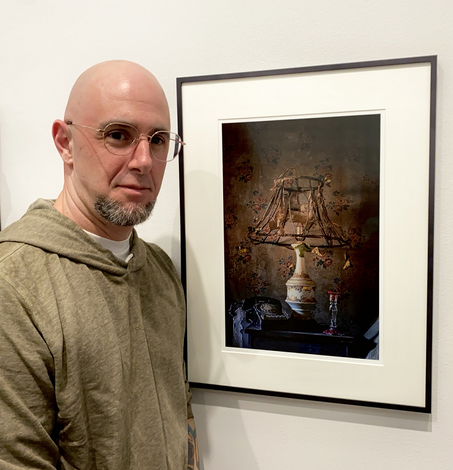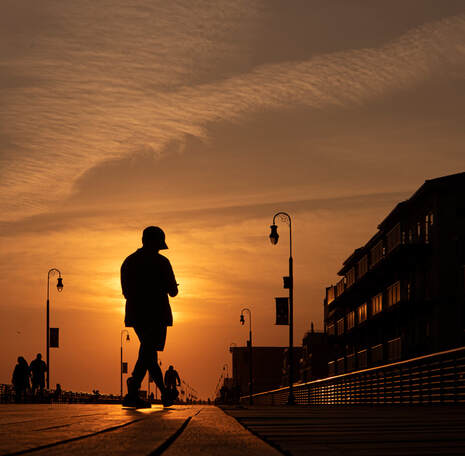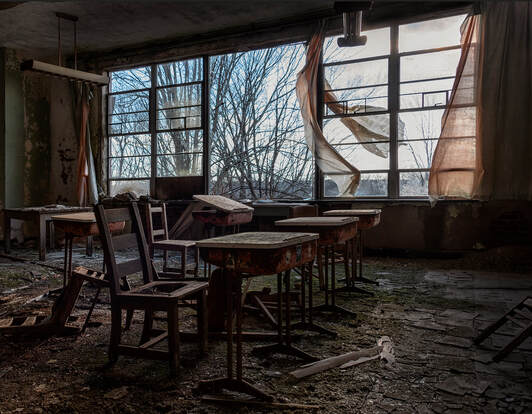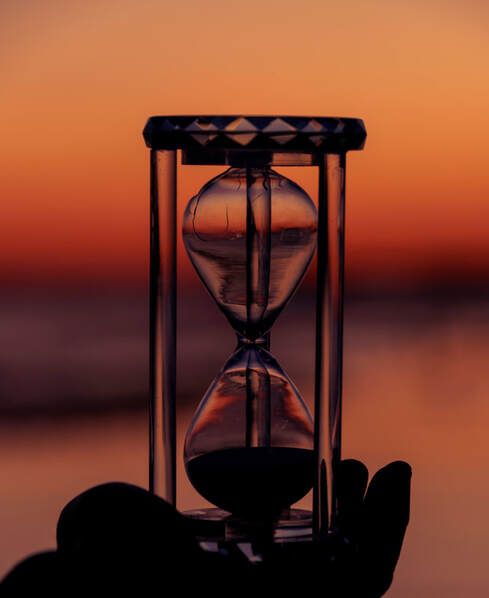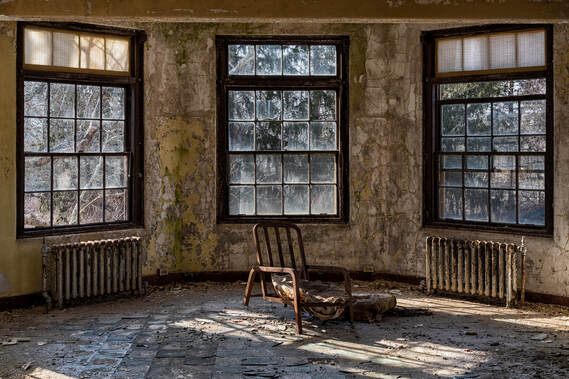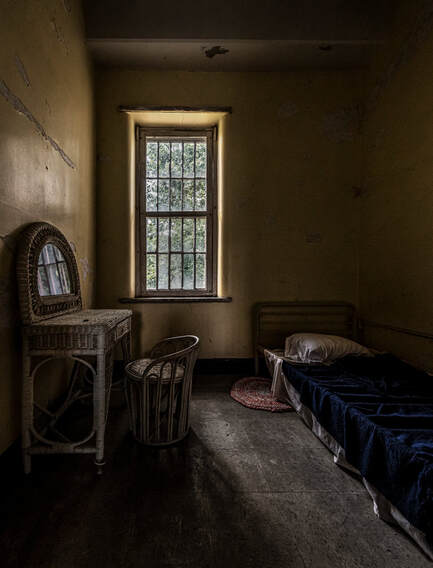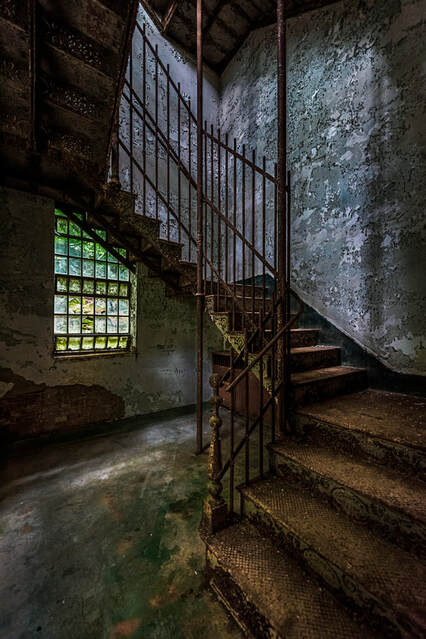JUNE 2023: Featured Artist
The Beauty in Decay and Abandonment
Fine Art Photographer:
Paul Mele
|
Paul Mele with his piece "Waiting on a Call from You"
Photo Credit: Pamela Waldroup |
A fotofoto gallery and Firefly Artists Gallery member artist, Paul Mele is a photographer living and working on New York’s Long Island. His photographs often illustrate time’s way of imposing its will upon all things and the wreckage it leaves behind. His work has been often described as both “moody” and “painterly.” To achieve his vision, Paul shoots, edits and prints his own work. He holds certifications in photography from both Nassau Community College on Long Island and the International Center of Photography in New York City. He has also studied with Vincent Versace and Neal Parent at the Maine Media Workshop, and with Carlan Tapp at the Santa Fe Photographic Workshop. His work has been exhibited on Long Island and in New York City, including fotofoto gallery, Mills Pond Gallery, the LI Biennial at Heckscher Museum of Art, NYC4PA, Huntington Arts Council, Huntington Arts Center, MOCA, Art League of Long Island, Guild Hall, A Smith Gallery, Salmagundi Club, b.j. spoke gallery, Alfred Van Loen Gallery, Michael Braceland Art Gallery, The Solarium at Houghton Hall, Soho Photo, Long Island Museum, Praxis Galley in MN, and in online exhibitions hosted by Plymouth Center for the Arts and the Hamptons Art Hub. |
Paul discusses his process, his focus on contrasts, and how personal life events have influenced his work.
When did you first become interested in photography?
I always had an interest in the arts. Music was always my first obsession. Drawing was something I wished I could do, but that was just not in the cards for me. As I got older and started going to concerts, I would always take a camera with me. I had no idea what I was doing, but I would just shoot away, roll after roll, and hope for the best. I would see others' photographs, and I never understood how they would get those amazing images.
When did you first become interested in photography?
I always had an interest in the arts. Music was always my first obsession. Drawing was something I wished I could do, but that was just not in the cards for me. As I got older and started going to concerts, I would always take a camera with me. I had no idea what I was doing, but I would just shoot away, roll after roll, and hope for the best. I would see others' photographs, and I never understood how they would get those amazing images.
|
Oblivious
Postcards Series © Paul Mele |
When I was eighteen, I attended Nassau Community College as a liberal arts major. We were told we had to take electives as part of the curriculum. Photography was one of my options. I had no idea how much time and money was needed to fully invest in this field, and I don’t remember if I finished the class. But I do remember loving it.
In 2001, I was studying computer science at Molloy College. While on vacation with some friends, I ended up in a life-altering car accident. It took me three years to get back on my feet, and what I had learned in the ever-changing computer field was outdated. My friend Dave asked me what I planned to do now that my life had settled back down, but I honestly had no idea. He mentioned going back to school and reminded me how much I loved photography. I now had the time and inclination to invest in it. What do you love most about this medium? To me, the art of photography has three stages: image capture, editing and printing. While I love going out and exploring and capturing moments with my camera, it is the editing that is truly my favorite part of the entire process. Editing is where I get to put my stamp and personality into the photograph. This is what separates my work from the rest of the pack. |
Photoshop allows me to become the painter I always wished I could be. I have full control over the final product and the viewer sees just what I want them to see. When I am out in the field shooting, I have a working concept in my head of how I want the end product to look. Sometimes it’s almost the same as the initial capture, and sometimes there’s more manipulation to achieve my final vision. I am not a purist. I use all tools at my disposal to push my grand design over the goal line. I used to get lost in the darkroom for hours working on one print. I now do the same while sitting in front of my computer. I also do my own printing.
|
What attracts people to ruin and decay – abandoned buildings, decayed items left behind after a disaster?
I believe that the attraction to abandoned places is a mixed bag. Everyone has their own agenda when seeking out these gems. I have several theories. Some people are attracted to what they are scared of most, and in these cases, it’s what could be inside these abandoned structures. People carry their fears wherever they go, and not knowing what they are in for can trigger these fears. I have often been asked if I have experienced any paranormal activity. I do not believe in that. My second theory is trespassing for the sake of vandalism. People break in, smash windows, tag the walls with graffiti, and use these places as their own personal playgrounds with no regard for their history or the purpose they once stood for. I find this repulsive. There are buildings that have been set on fire and, sadly, were forced to be knocked down. |
School's Out
In Absentia Series © Paul Mele |
|
Piece of Time
Postcards Series © Paul Mele |
My final theory is the one I truly adore – the explorers who leave only footprints. They enter to relive the past, document with their cameras, and capture nature and time retaking their rightful place once humanity has walked away. Some of these places, if not vandalized, can serve as a time capsule. Photographs, beds, books, records, silverware – these personal items carry their weight in history and leave untold stories behind, whether glorious or tragic, they are covered with the dust of the past.
Is it the random nature of decay that interests you most? Do you find decay beautiful? “Time is truth, hard and cruel” is a quote from a song titled ‘Crawl Back In’ by Neurosis and a line that has always stuck with me. My attraction to decay has always been linked to my obsession with time and the toll it takes on all things, living or inanimate. Time always wins in the end, but if nurtured, buildings can last for centuries. What I find amazing is what happens after humanity decides to let go and leave these structures to their own devices. Some places can fall apart in just a short period of time, others may take longer. One room can look untouched while another has paint peeling off the walls and asbestos caked along the floors. The true beauty, however, is the natural light that creeps in every day – the sun continues to do its job, while the structures continue to rot away bit by bit. The sun illuminates these facilities and breathes life into them each day before the night closes in and lulls them back to sleep. It’s in these moments that the magic happens, and their natural beauty is on full display. |
|
While perusing the series In Absentia, I’m drawn to the textures created by the process of decay. It seems the “souls” of the spaces are screaming for attention. Any thoughts on what you hope the viewer takes away from these images?
When I start assembling a new body of work, I usually do not set out with a theme in mind. In Absentia was no different. These images were shot in several different locations over a period of time with no real intention but to shoot and see what happens. Throughout this process, the images all started talking to one another, and then they began talking to me. As I got closer to the work, a pattern began to form, and the narrative was born. It was about much more than just random photographs, textures and abandoned places – it was about people, their homes, jobs, toys, habits. Their souls were imprinted in these spaces making each photograph a self-portrait of a stranger I will never meet. And like most of my titles, In Absentia came from what influences me most – music. The series takes its title from a Porcupine Tree album and the definition is appropriate for what I hope viewers feel: “While the person involved is not present." |
Homesick
In Absentia Series © Paul Mele |
|
We Dreamed of Two
CONFINEMENT Series © Paul Mele |
Let’s discuss your use of light which is integral in setting the mood.
I never got the hang of off-camera flash or strobes. I would much rather use natural light and carry a tripod in case there is a major difference in F Stops between the light and the shadows. I will either under expose by a stop or two or bracket to make sure I have several files to work with of the same capture, ensuring there is enough information in the highlights and in the shadows so I can create depth later. While editing, I like to paint with light and force the viewers eyes to maneuver throughout the photo as I see fit, but I also want to make sure that the light source looks as natural as possible. If a light is coming through a window at a certain angle, then only the subject in that path should be lit up. The light should fall off naturally while the darker areas remain dark but still have enough information, so they do not go completely black. I don’t want them to look like silhouettes. Your eyes can balance light much better than a camera can. I want that natural look. My intention is to create a mood, a feeling of foreboding all the while keeping a sense of hope glimmering in the brighter spaces of the photograph. It’s fun to walk the line between the darkness and the light. The duality leaves more room for interpretation. Are you escaping the dark, or are you heading towards it? |
Concerning your series CONFINEMENT: You draw attention to patterns (e.g. the window grills and stair railings), decay, and a sense of isolation. What was the inspiration for this series?
CONFINEMENT came to me organically – the series seemed to be pursuing me. As I began the editing process, all of my images felt like insulated moments that had no escape. They were all traps. The outside world was still there, but it was always barred off. The rooms felt tighter. There was less air to breathe. My work never felt this claustrophobic before, but the feelings evoked were very familiar. Each image carries its own weight in grief, but they also expel some form of illuminated hope.
CONFINEMENT came to me organically – the series seemed to be pursuing me. As I began the editing process, all of my images felt like insulated moments that had no escape. They were all traps. The outside world was still there, but it was always barred off. The rooms felt tighter. There was less air to breathe. My work never felt this claustrophobic before, but the feelings evoked were very familiar. Each image carries its own weight in grief, but they also expel some form of illuminated hope.
|
Twenty-one years ago, I ended up in a hospital for three months, a wheelchair for nine months, and physical therapy for over three years due to a car accident. My world crumbled. Hospital beds, a wheelchair, crutches, ambulette rides and forever being a passenger became my way of life. Everything was put on hold. Everything was closing in.
Some moments can stay with us forever. They can cause physical and mental pitfalls. Some holes we can easily climb out of, some we tread water in, and some may cause us to drown entirely. There is only so much optimism to go around. I’ve learned to live within my limitations. Stairs had become my sworn enemy. I was trapped, living in my parent’s basement on a diet of endless TV shows and PT sessions. The end never felt within reach. Each photograph in CONFINEMENT speaks to the trials and tribulations I faced either physically or metaphorically throughout my rehabilitation and the suffocating feelings and anxiety it caused. The room in “Mandatory Bed Rest” brought me back to the same sterile smelling hospital room with the same redundant window view, day in and day out. “Staircase Infinities” and “Where We Part Ways” is my tribute to my aversion for staircases even though they can be quite breathtaking. “Time Never Gets Old” and “A Prison Of Light” is more about my mental state and how incarcerated I felt inside my own mind. “I Am A Cliché” brought me back to the never-ending doorways leading to numerous waiting rooms and doctor’s offices. My personality and dark sense of humor had always been reflected in my work – the themes, the titles, the way I edit – but they never got personal before. This felt like a first for me. I guess sometimes your past comes home for a visit. |
Staircase Infinities
CONFINEMENT Series © Paul Mele |
Many of your images include clowns or figures with masks. A mask can disguise what the person wearing it doesn’t want others to see (either figuratively or literally). Is this what draws you to clowns and subjects in costume? Are you commenting on fear of the unknown?
I have always been drawn to both the theatrical nature and the absurdity of the circus. When my parents took me to see the Ringling Bros. and Barnum & Bailey Circus as a child, I was enthralled by the spectacle – the clowns, the animals, the music, the lights, the colors – it was just so different from everyday life. It carried a sense of both danger and humor. Both kept me on the edge of my seat.
I have always been drawn to both the theatrical nature and the absurdity of the circus. When my parents took me to see the Ringling Bros. and Barnum & Bailey Circus as a child, I was enthralled by the spectacle – the clowns, the animals, the music, the lights, the colors – it was just so different from everyday life. It carried a sense of both danger and humor. Both kept me on the edge of my seat.
|
|
As I got older, the atmosphere of the circus always stayed with me, and I soon discovered how it used to be back in the 1930s. It was a much darker environment in both tone and in spirit, a seedy world where the characters were a lot less colorful and a lot more ragged.
These two different environments represented my personality to a tee. I have a child’s sense of wonder with a morbid sense of humor. When I created my Pure Imagination series, it was not a commentary about the fear of the unknown, it was a commentary on my personality. The duality of my sense of humor comes out greatly in my work because of the way I edit. I like to keep things dark and moody, but there is always a hint of hope and light bleeding through. It keeps the viewers on edge, and they are free to take the path they choose. The circus has always carried that duality. There are eleven images in total in Pure Imagination. Each was named after something that reflected my interests. Some after family pets, others after TV characters. ‘Rory’ was named after an alias a character used on the Simpson’s cartoon. ‘Mary Bell’ was named after a twelve-year-old who killed two children back in 1968. The pendulum is always swinging. |
Please explain your use of pops of color in the series Return to Desolation: Within the Remains, Part 2.
Return to Desolation was the second part of my Within The Remains series. All the photographs in this series were taken at the Kings Park Psych Center. The KPPC was the first place I explored, and I was still trying to find my voice, both in shooting and editing. The colors in these images already existed but were just a tad more subdued. I definitely wanted to make them pop. I also wanted my images to look different from other pictures I have seen of the Psych Center over the years.
Natural light plays a big part in the overall outcome of the colors. Time of day and year play an important role. During the summertime, the light is much stronger, and the trees cast a green hue through the windows making the buildings much more inviting. I wanted to capture the beauty of these buildings and show people they are much more than just a derelict structure awaiting its fate. I rarely add things that do not exist in my photographs, but I will enhance what is there for the sake of the final product.
Return to Desolation was the second part of my Within The Remains series. All the photographs in this series were taken at the Kings Park Psych Center. The KPPC was the first place I explored, and I was still trying to find my voice, both in shooting and editing. The colors in these images already existed but were just a tad more subdued. I definitely wanted to make them pop. I also wanted my images to look different from other pictures I have seen of the Psych Center over the years.
Natural light plays a big part in the overall outcome of the colors. Time of day and year play an important role. During the summertime, the light is much stronger, and the trees cast a green hue through the windows making the buildings much more inviting. I wanted to capture the beauty of these buildings and show people they are much more than just a derelict structure awaiting its fate. I rarely add things that do not exist in my photographs, but I will enhance what is there for the sake of the final product.
|
|
UPCOMING EXHIBITIONS:
fotofoto gallery Oct 19 through Nov 11 Reception: Saturday, Oct 21 ~ 5:00 p.m. to 7 p.m. Huntington, NY Work Regularly on Display at: The Firefly Artists Gallery Northport, NY. |

